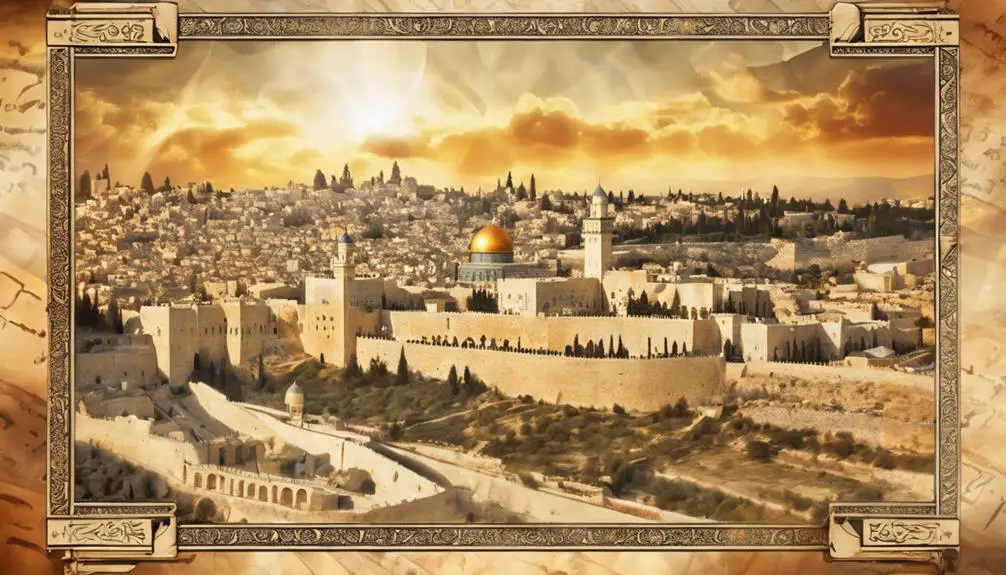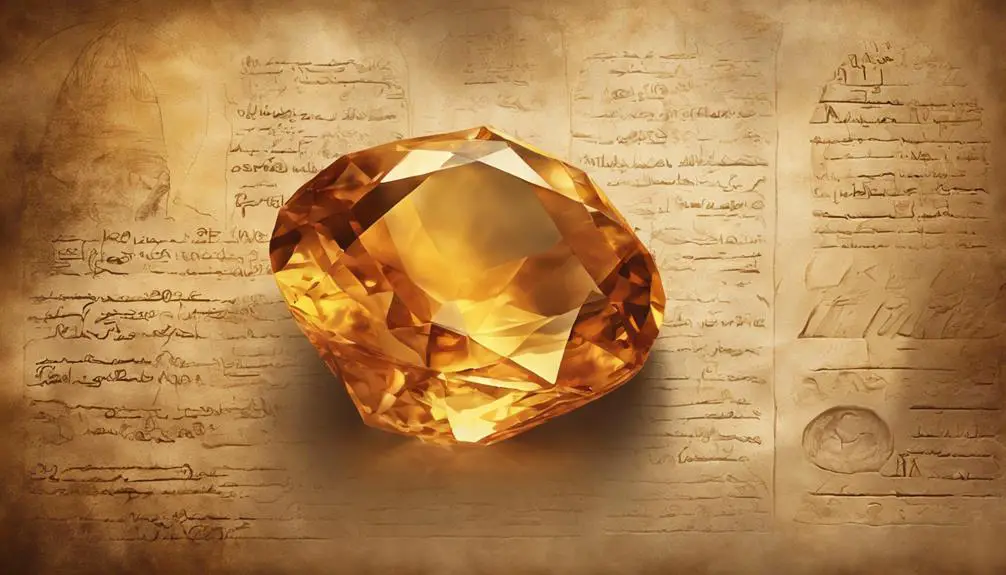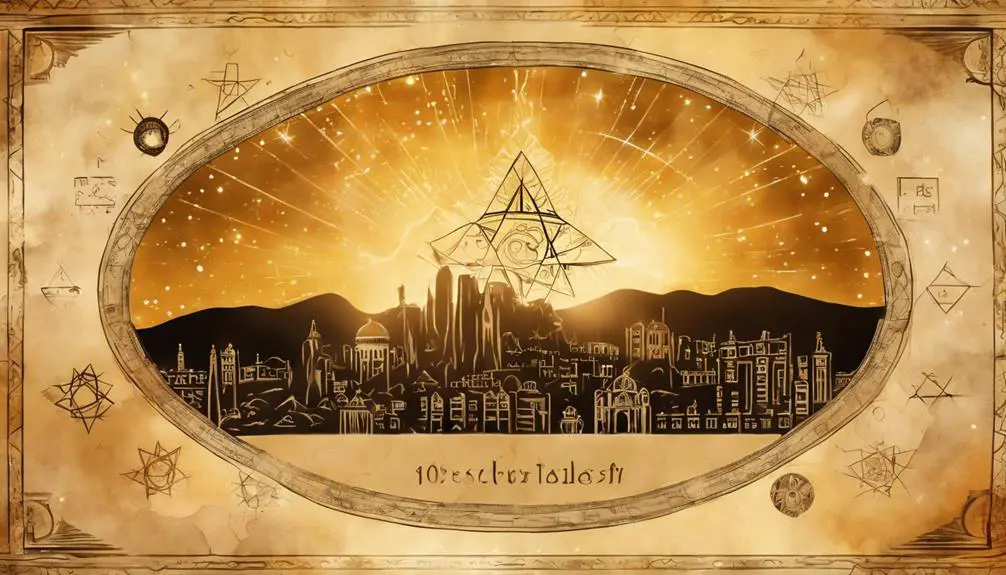Highlighting topaz's biblical journey, discover the gem's ancient symbolism and its profound impact on history—what secrets does it hold?

Topaz in the Bible
You've likely heard theories about the significance of topaz in biblical texts, but how much truth is there to these claims?
As you explore the historical and symbolic meanings of topaz, from its mention in Exodus to its role in the High Priest's breastplate, and its appearance in Revelations, you'll uncover layers of interpretation that have evolved over centuries.
The journey into understanding topaz's biblical context reveals not just the gemstone's value but also offers a deeper insight into the cultures that cherished it.
What might these ancient texts reveal about the way we view topaz today? Let's find out together.
Key Takeaways
- Topaz symbolizes divine glory and purity in biblical contexts, especially noted in Revelations.
- It is featured on the High Priest's breastplate, representing the tribes of Israel and divine protection.
- The gemstone's inclusion in religious artifacts signifies its value and rarity in ancient times.
- Topaz's varied colors and origins contribute to its symbolic meanings of generosity, strength, and spiritual connection in the Bible.
Historical Significance of Topaz

Throughout history, topaz has played a significant role in various cultures, often symbolizing wealth and power. This gemstone, prized for its dazzling array of colors and remarkable clarity, has been sourced from various locations around the globe. The quest for topaz sources has led to the discovery of significant deposits in Brazil, Russia, and Pakistan, among other regions. These sources have contributed to the widespread availability and varied qualities of topaz found today.
Your understanding of gemstone authenticity, particularly concerning topaz, is crucial for appreciating its historical significance. The authenticity of a topaz gemstone not only pertains to its natural versus synthetic origin but also to its treatment. Many topaz stones undergo treatments to enhance their color or clarity, practices that date back centuries. These enhancements, while common, raise questions about the value and authenticity of the gemstones.
Scholars have analyzed the implications of these practices on the perception of topaz through history. The authenticity of topaz, impacted by its source and treatment, has influenced its role in various cultures. For instance, the value placed on a piece of topaz in ancient times often depended on its perceived purity and origin. This perception directly influenced its symbolic association with wealth and power.
Topaz in Exodus

Understanding the historical significance of topaz enriches our appreciation of its mention in Exodus, where it's listed as one of the stones on the High Priest's breastplate. This context provides a fascinating insight into the ancient world's valuation of gemstones, particularly topaz, which holds a distinguished place among the sacred adornments. The precision in gem identification during this period is noteworthy, as the identification and classification of gemstones were based on observable qualities rather than the chemical and physical properties understood today.
The mention of topaz in Exodus underlines its importance and rarity, suggesting that ancient societies had established and sophisticated mining locations. These locations, although not explicitly documented in biblical texts, are believed to have been in regions known for their rich mineral deposits. Historical records and archaeological findings suggest that the topaz used in high-status objects like the High Priest's breastplate likely came from areas that are part of modern-day Egypt and the surrounding regions, which were renowned for their gemstone mines.
The inclusion of topaz in such a significant religious artifact highlights its esteemed status and the advanced level of gemstone procurement and processing at the time. The mining locations for topaz and other gemstones were highly valued for their contributions to religious and cultural practices, underscoring the interconnectedness of geology, trade, and spirituality in ancient societies. This deepens our understanding of the societal structures and priorities of the time, reflecting an era where the value of natural resources extended beyond the ornamental to the spiritual and ceremonial realms.
Symbolic Meanings of Topaz

Delving into the symbolic meanings of topaz, one finds that this gemstone has been imbued with a multitude of significances across various cultures and historical periods. The diversity in topaz colors, ranging from clear, to golden yellow, to blue, has contributed to its rich symbolic tapestry. These colors aren't just visually striking; they carry deep symbolic weight, influenced by the topaz origins and the cultural contexts in which they were interpreted.
In many traditions, the golden hue of topaz is often associated with the sun and its life-giving warmth. This connection positions topaz as a symbol of generosity, abundance, and strength. The clear or transparent topaz, on the other hand, has been linked to purity and honesty, suggesting a clarity of the soul and mind. Meanwhile, the blue varieties of topaz are frequently seen as emblems of calmness, serenity, and spiritual connection, reflecting the tranquil depths of the sea and sky.
The geographical origins of topaz have also played a significant role in shaping its symbolic meanings. For instance, topaz from specific locales might be attributed with unique powers or significance, influenced by local lore and spiritual beliefs. This connection between place and meaning underscores the importance of understanding the origins of topaz to fully appreciate the depth of its symbolic significance.
Topaz in Revelations

In the Book of Revelation, topaz is mentioned as the ninth stone adorning the foundations of the New Jerusalem, symbolizing divine glory and purity. This inclusion within apocalyptic imagery serves not only as a testament to topaz's esteemed value but also as a beacon of hope and restoration in the climax of biblical prophecy. The choice of topaz, among other gemstones, to represent the New Jerusalem's foundation is particularly telling of its significance within both historical and theological contexts.
To understand the depth of topaz's role in Revelations, consider the following aspects:
- Gemstone Origins: Topaz is known for its wide range of colors, from yellow to deep golden, blue, pink, and even clear. This versatility may symbolize the multifaceted nature of divine glory. The gemstone's origins, often linked to the legendary island of Topazios in the Red Sea, underscore its rarity and value, enhancing its symbolic weight in apocalyptic imagery.
- Symbolic Representation: In biblical times, gemstones like topaz weren't merely ornamental but carried deep symbolic meanings. In Revelations, topaz's placement as the ninth stone could signify completeness and faithfulness, traits attributed to God's eternal kingdom.
- Apocalyptic Imagery: The use of topaz in the depiction of the New Jerusalem is part of a broader tapestry of apocalyptic imagery, designed to convey the splendor and unshakeable foundation of the divine realm. This imagery serves as a vivid reminder of the promised restoration and the ultimate victory of good over evil.
In analyzing topaz's presence in Revelations, it becomes clear that its inclusion is far from arbitrary. It reflects a deeply rooted belief in the gemstone's ability to convey messages of purity, glory, and divine promise.
The High Priest's Breastplate

Topaz, among other precious stones, plays a critical role in the composition of the High Priest's Breastplate, symbolizing not only the tribe of Israel it was associated with but also carrying profound theological implications. This gemstone, revered for its beauty and rarity, was intricately woven into the fabric of ancient religious practices. The gemstone origins trace back to specific locations known for their mineral wealth, indicating a complex network of trade and knowledge that facilitated the acquisition of such precious stones for sacred purposes.
Crafting techniques employed in the creation of the High Priest's Breastplate were advanced for their time, showcasing a remarkable level of skill and dedication. Each stone, including topaz, was carefully selected and prepared, then set into the breastplate with precision. This meticulous process ensured that the breastplate wasn't only a functional religious garment but also a work of art, embodying the spiritual and temporal leadership of the High Priest.
The inclusion of topaz in the breastplate symbolized a connection between the divine and the earthly realms. It served as a tangible representation of the divine protection and guidance bestowed upon the tribes of Israel. The choice of topaz, with its striking color and clarity, was likely intended to invoke specific spiritual qualities or blessings associated with the tribe it represented.
Modern Interpretations of Biblical Topaz

Reflecting on the historical significance of topaz in the High Priest's Breastplate, scholars now explore its modern interpretations and the evolving understanding of this biblical gemstone. The discourse surrounding topaz in contemporary times interweaves both spiritual and scientific perspectives, offering a multifaceted view of its significance.
Here are three key aspects of the modern interpretations of biblical topaz:
- Topaz Healing Properties: Modern enthusiasts and some alternative medicine practitioners attribute various healing properties to topaz, echoing ancient beliefs. They claim that topaz can promote mental clarity, emotional stability, and physical rejuvenation. While these claims lack scientific backing, they reflect a continued spiritual interest in the gemstone, similar to its revered status in biblical times.
- Topaz Authenticity Concerns: In today's market, the authenticity of topaz has become a significant issue. With advancements in gemstone synthesis and treatment, distinguishing genuine topaz from artificially enhanced or counterfeit stones is increasingly challenging. Scholars and gemologists emphasize the importance of verifying topaz authenticity to preserve its historical and spiritual value, drawing parallels to its esteemed position in biblical narratives.
- Symbolic Interpretations: Contemporary biblical scholars often delve into the symbolic meanings of topaz as mentioned in scripture. They analyze its representation of beauty, protection, and divine favor, considering how these interpretations have evolved or remained consistent over millennia. This analytical approach helps bridge ancient texts and modern spirituality, offering insights into the enduring significance of topaz in religious and cultural contexts.
As scholars continue to unravel the complexities of biblical topaz, they contribute to a deeper understanding of its place in both ancient and modern worlds, underscoring the timeless allure of this mesmerizing gemstone.
Frequently Asked Questions
How Did Ancient Civilizations Beyond Israel, Such as the Egyptians or Babylonians, Value or Use Topaz in Their Religious or Cultural Practices?
You're exploring how ancient civilizations, like the Egyptians or Babylonians, valued or used topaz in their traditions.
These cultures highly prized topaz, incorporating it into topaz jewelry and artistic depictions, reflecting its significance. In Egypt, it symbolized the sun god Ra, showing its divine connection.
Meanwhile, Babylonians believed topaz possessed magical properties, using it in rituals.
Both civilizations' practices underline topaz's profound cultural and religious importance beyond its aesthetic value.
Are There Specific Rituals or Ceremonies in Contemporary Religions or Cultures That Still Use Topaz as a Symbolic or Sacred Stone?
Old habits die hard, and the allure of topaz is no exception. In your exploration, you'll find that contemporary religions and cultures still cherish topaz as a sacred stone, albeit in more modernized ways.
Topaz jewelry isn't just a nod to modern fashion; it serves as a bridge between ancient symbolism and contemporary expression. These pieces are often central to rituals or ceremonies, embodying both beauty and spiritual significance in today's world.
How Does the Scientific Composition and Geographical Sourcing of Topaz Compare Between the Biblical Era and Today?
You're exploring how the scientific composition and geographical sourcing of topaz have evolved.
Nowadays, topaz identification involves advanced techniques, revealing a broader spectrum of color variations than previously recognized.
Historically, sources were more limited, often not as precisely identified.
Today's topaz comes from diverse locations worldwide, showcasing a wider array of colors due to technological advancements in gemology.
This evolution reflects both our improved understanding of gemstones and the globalization of their trade.
Can Topaz Found in Different Regions of the World Have Varying Spiritual or Metaphysical Properties According to Biblical or Historical Interpretations?
Yes, topaz from different regions can have varying spiritual or metaphysical properties, even without delving into biblical contexts. Modern interpretations often link topaz color to specific attributes or energies.
For example, blue topaz might be associated with calm and communication, while golden topaz could represent wealth and protection. This idea isn't new; historical beliefs also tied stones' origins and colors to their perceived powers, showing a continuity in human fascination with gemstone symbolism.
What Are the Ethical Considerations Surrounding the Mining and Trade of Topaz in the Context of Preserving Historical Sites Mentioned in the Bible?
When considering the mining and trade of topaz, you must weigh the ethical implications, especially regarding historical preservation. Mining ethics demand responsible practices that protect archaeological sites, while trade transparency ensures that the provenance of topaz respects cultural heritage.
It's crucial to balance economic benefits with the preservation of history, ensuring that the extraction and sale of such precious stones don't compromise the integrity of historically significant locations.
Conclusion
In conclusion, topaz's luminous presence in the Bible isn't just another pebble on the path of religious texts but a beacon, illuminating the rich tapestry of symbolism and historical significance that stones carry in biblical narratives.
From its role in Exodus to its appearance in Revelations, topaz serves as a testament to the enduring power of symbols in conveying profound spiritual truths. Its inclusion in the High Priest's Breastplate and modern interpretations further cements its legacy, making it a gemstone of not only physical but also of immense spiritual brilliance.



Sign up